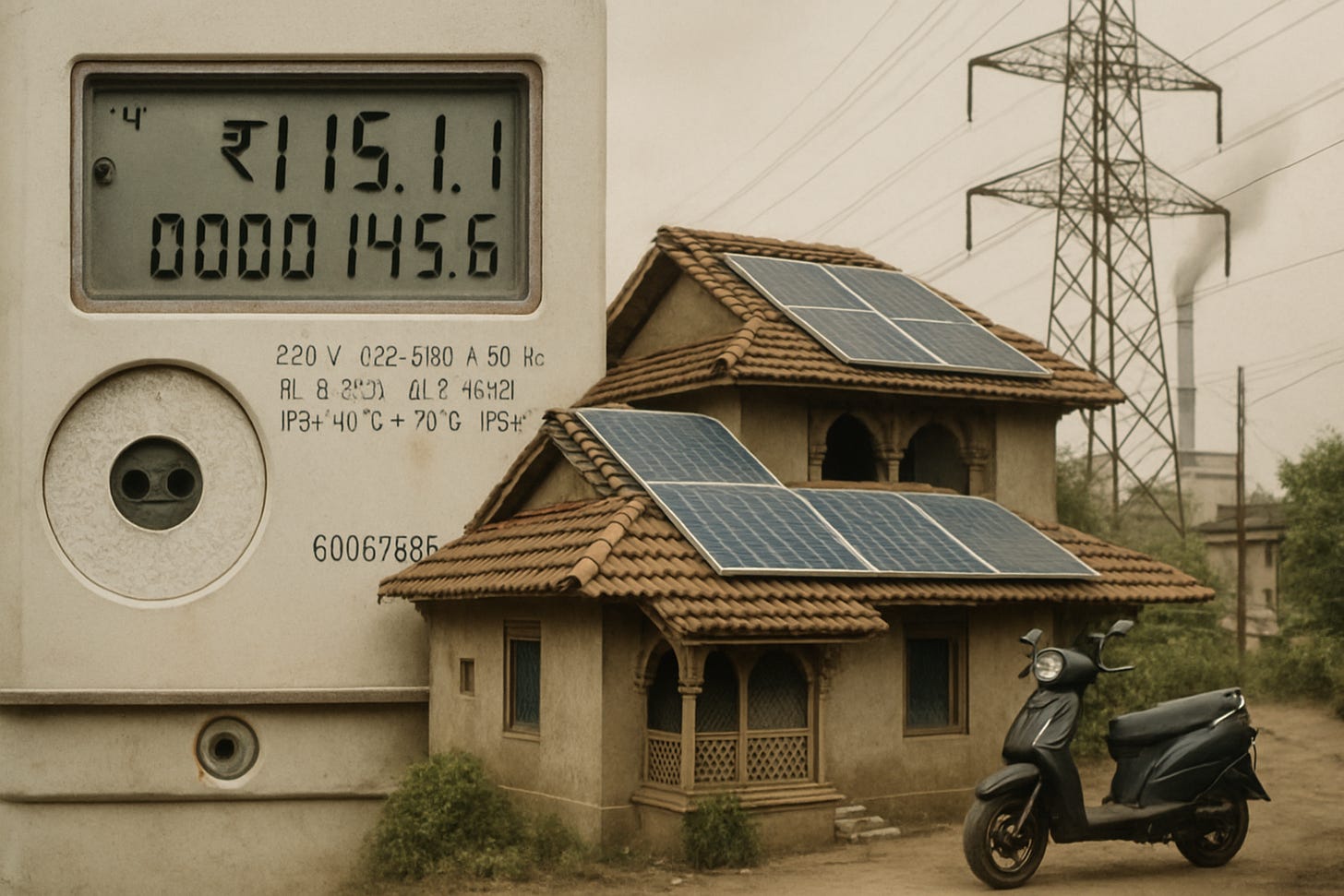Smart Grids, Equity, and Who Controls the Switch
Smart grids hold the promise of a cleaner and resilient energy system if paired with public understanding and inclusive regulation.
View as PDF
Malavika Vipin, IIT Madras, India.
Santosh Kumar Sahu, IIT Madras, India.
Satyanarayanan Seshadri, IIT Madras, India.
SDG 7: Affordable and Clean Energy | SDG 9: Industry, Innovation, and Infrastructure
Institutions: Ministry of Power | Ministry of New and Renewable Energy
As India races to expand and modernise its electricity system, smart grids have emerged as a policy favourite. These digitally enabled networks sit between power generators and consumers, using sensors, software, and real-time data to better balance electricity supply and demand, reduce costs, and improve the reliability of the grid. By enabling quicker responses to outages and integrating renewable sources like solar and wind, smart grids promise not only technical efficiency but a shift in power relations - from centralised control to what some call “energy democracy,” where households and communities can participate in generation, management, and decision-making.
Yet this promise is not a silver bullet. Questions on energy literacy in navigating the technical sophistication of smart grids remain. So do the questions on information flow - or the lack of it - between the state, grid and households to maintain quality, efficiency, and inclusion. These questions are important to address so that smart grids do not risk reinforcing the very inequity - in access to quality power supply - they are meant to fix by democratising energy.
The Misunderstood Fix: Human Infrastructure
Smart grids allow energy systems to become more democratic, where households can serve twin roles: as producers, they supply electricity to power utilities (electricity distribution companies) from their rooftop panels and generate income; and as consumers, they avail electricity from power utilities while simultaneously tracking their usage. Power utilities do real-time demand management by using digital tools and pricing off-peak-hour demand lower than peak-hour demand.
This potential of smart grids is already visible in some parts of the world. In Germany, about one-third of renewable capacity is citizen-owned, largely through cooperatives supported by digital transparency and enabling policies. In Brooklyn, peer-to-peer energy trading pilots show how neighbourhood-level energy exchange can lower costs, improve grid stability, and integrate renewable energy more effectively.
This vision is only as effective as the users and institutions that support it. In India, smart meters, a core part of smart grid infrastructure, were meant to enable real-time monitoring, flexible tariffs, and automated billing. Over 1.5 million households were covered under the Smart Meter National Programme launched in 2017. Yet a 2022 survey in West Bengal found that fewer than 12 percent of low-income households understood how their electricity bills were calculated. Most had never seen the data their smart meters generated.
Smart infrastructure without energy literacy risks becoming disempowering rather than democratic. Real-time data only builds trust and participation when people understand it, believe it, and can act on it. Otherwise, it simply accelerates a system that remains opaque, with new technologies but old exclusions.
The Latitudes of Energy Equity
The risk of exclusion compounds the problem with smart grids. Over 82 percent of subsidised rooftop installations are concentrated in just four states – Gujarat, Maharashtra, Uttar Pradesh and Kerala, and predominantly among top income deciles. Renters, informal settlement residents, and rural households are largely locked out, lacking not only capital but also land tenure, documentation, or digital access.
Even when communities with limited digital access, income or formal education are connected to smart grids through state programs, the risks of misbilling or misfit service remain prominent. Behind this lies a deeper agency problem among the key players. The state relies on power utilities to execute policy but lacks the granular data to monitor results. Utilities, in turn, operate with limited feedback from communities. Local bodies and households are rarely consulted in planning or oversight. Without mechanisms for transparency and accountability, the promise of decentralised and inclusive control risks remaining a rhetorical flourish.
If not carefully governed, smart grids may reinforce centralisation under a digital guise, especially when vendor-driven deployments dominate, with minimal community consultation or ownership. Even basic data governance is a blind spot. Smart meter data being personal data, concerns around privacy and security are paramount, requiring a clear legal framework for data privacy, local grid governance, or community participation.
The Policy Slant
The regulatory solutions needed are not radical; they are overdue. Governments can begin by mandating local community advisory boards in utility planning processes, ensuring that the shift to smart infrastructure includes public oversight from the outset. Smart grid funding should be contingent on demonstrable investments in energy literacy, especially for rural and marginalised groups who are too often bypassed from both consultation and service quality.
Educational tools like infographics, workshops, and mobile platforms can be leveraged for citizen’s inclusion, but only when backed by policy mandates. Just as financial regulators insist on consumer disclosures and credit education, energy regulators must treat relevant literacy as a baseline requirement in smart grid deployment.
Power utilities must also be required to publish anonymised, disaggregated consumption data at the ward or block level. This would enable communities, civil society, and researchers to identify consumption patterns, assess equity outcomes, and propose evidence-based reforms. The need is pressing, given that smart meters in India already record usage every 15 minutes, and in some cases hourly, yet there is still no robust framework for privacy or citizen control over this data.
Finally, rooftop solar incentives must go beyond capital subsidies to include output-based payments - fixed amounts for every unit of electricity generated and fed into the grid. Such models would open participation to renters, low-income households, and cooperatives, creating not just greener grids but fairer ones.
A Smarter Grid, Not Just a Faster One
Energy systems are no longer just engineering puzzles. They are governance challenges, with social contracts embedded in every meter, every algorithm, every tariff.
By 2025, over 40 billion IoT devices will be online, and electric vehicle adoption will top $50 billion in annual sales. The digitalisation of energy is accelerating - but intelligence does not guarantee inclusion, and efficiency is no proxy for equity.
Smart grids can help decarbonise, decentralise, and democratise. Yet only decarbonisation happens by default. The rest depends on policy choices, civic imagination, and a willingness to reframe who gets to shape the energy future and who is left waiting for it.
View as PDF
Authors:

Views are personal.


